Electromyographic Validation of the DMA Clinical Pilates Method for Classifying Muscle Impairments in Chronic Ankle Instability
Abstract
1. Introduction
2. Materials and Methods
2.1. Study Design
2.2. Sample Size
2.3. Participants
2.4. Electromyography
2.5. Maximum Voluntary Isometric Contraction
2.6. Experimental Procedures
2.7. Data Management
2.8. Statistical Analysis
3. Results
3.1. Healthy vs. Chronic Ankle Instability
3.2. Recovered vs. Chronic Ankle Instability
4. Discussion
5. Conclusions
Author Contributions
Funding
Institutional Review Board Statement
Informed Consent Statement
Data Availability Statement
Acknowledgments
Conflicts of Interest
Abbreviations
| DMA | Dance Medicine Australia |
| EMG | Electromyography |
| MVIC | Maximum voluntary isometric contraction |
| BF10 | Bayes factor 10 |
Appendix A
| Pose-Muscles | %MVIC, Mean (SD) | BF10 | Median | 95% CI | |
|---|---|---|---|---|---|
| Healthy | CAI | ||||
| Dom stance: | |||||
| Gmed | 9.55 (4.41) | 12.99 (10.65) | 0.58 | 0.32 | −0.30 to 1.00 |
| Gmed (non-dom) | 28.85 (19.73) | 30.38 (18.52) | 0.35 | 0.06 | −0.56 to 0.69 |
| LD | 10.54 (5.82) | 32.18 (26.30) | 11.86 ** | 0.98 | 0.23 to 1.79 |
| LD (non-dom) | 61.41 (67.47) | 71.52 (79.44) | 0.36 | 0.10 | −0.51 to 0.74 |
| Gluteus maximus | 29.28 (27.64) | 26.18 (14.04) | 0.39 | −0.12 | −0.79 to 0.51 |
| Vastus lateralis | 25.75 (10.88) | 36.79 (13.27) | 3.24 * | 0.73 | 0.04 to 1.50 |
| Tibialis anterior | 18.56 (15.98) | 34.72 (17.60) | 4.06 * | 0.78 | 0.08 to 1.55 |
| GasM | 42.35 (39.56) | 58.17 (46.58) | 0.51 | 0.27 | −0.34 to 0.94 |
| Fibularis longus | 46.67 (19.94) | 55.78 (30.29) | 0.50 | 0.26 | −0.35 to 0.93 |
| Non-dom stance: | |||||
| Gmed (dom) | 6.82 (5.30) | 6.64 (3.32) | 0.35 | −0.03 | −0.65 to 0.59 |
| Gmed | 30.60 (22.65) | 34.56 (24.48) | 0.37 | 0.12 | −0.49 to 0.76 |
| LD (dom) | 14.26 (41.29) | 4.92 (6.33) | 0.45 | −0.22 | −0.88 to 0.39 |
| LD | 21.03 (22.33) | 30.53 (40.06) | 0.44 | 0.22 | −0.39 to 0.88 |
| Gluteus maximus | 21.50 (31.44) | 19.51 (25.38) | 0.35 | −0.05 | −0.68 to 0.57 |
| Vastus lateralis | 34.32 (14.21) | 39.92 (16.90) | 0.50 | 0.26 | −0.35 to 0.93 |
| Tibialis anterior | 28.85 (12.22) | 58.36 (28.70) | 36.36 *** | 1.18 | 0.38 to 2.01 |
| GasM | 36.84 (25.20) | 64.15 (93.74) | 0.55 | 0.30 | −0.31 to 0.98 |
| Fibularis longus | 47.02 (25.15) | 46.08 (22.55) | 0.35 | −0.03 | −0.65 to 0.59 |
| Pose-Muscles | %MVIC, Mean (SD) | BF10 | Median | 95% CI | |
|---|---|---|---|---|---|
| Healthy | CAI | ||||
| Dom stance: | |||||
| Gmed | 10.63 (5.09) | 14.47 (10.78) | 0.64 | 0.35 | −0.27 to 1.04 |
| Gmed (non-dom) | 32.28 (22.57) | 32.72 (17.91) | 0.35 | 0.02 | −0.60 to 0.64 |
| LD | 18.59 (21.15) | 35.43 (36.02) | 0.88 | 0.44 | −0.19 to 1.15 |
| LD (non-dom) | 71.49 (97.28) | 83.97 (114.78) | 0.36 | 0.09 | −0.53 to 0.72 |
| Gluteus maximus | 24.43 (24.47) | 29.25 (19.20) | 0.39 | 0.16 | −0.45 to 0.80 |
| Vastus lateralis | 23.32 (12.41) | 35.51 (13.20) | 3.85 * | 0.77 | 0.07 to 1.54 |
| Tibialis anterior | 26.23 (16.18) | 61.30 (42.47) | 8.93 * | 0.93 | 0.19 to 1.73 |
| GasM | 43.64 (25.29) | 84.71 (59.36) | 3.35 * | 0.74 | 0.05 to 1.51 |
| Fibularis longus | 52.55 (24.79) | 66.01 (36.17) | 0.59 | 0.33 | −0.29 to 1.01 |
| Non-dom stance: | |||||
| Gmed (dom) | 6.83 (4.89) | 6.50 (3.55) | 0.35 | −0.06 | −0.68 to 0.56 |
| Gmed | 34.44 (23.06) | 33.67 (18.26) | 0.35 | −0.03 | −0.65 to 0.59 |
| LD (dom) | 4.53 (9.80) | 7.21 (10.41) | 0.42 | 0.19 | −0.42 to 0.85 |
| LD | 20.24 (32.51) | 27.83 (53.42) | 0.38 | 0.13 | −0.48 to 0.77 |
| Gluteus maximus | 14.30 (12.14) | 28.07 (34.77) | 0.79 | 0.41 | −0.22 to 1.11 |
| Vastus lateralis | 36.35 (16.94) | 43.14 (17.66) | 0.53 | 0.29 | −0.32 to 0.97 |
| Tibialis anterior | 37.86 (17.75) | 73.38 (43.11) | 8.22 * | 0.92 | 0.18 to 1.71 |
| GasM | 35.69 (20.00) | 70.72 (66.66) | 1.50 | 0.57 | −0.09 to 1.31 |
| Fibularis longus | 59.81 (42.36) | 56.36 (22.61) | 0.36 | −0.07 | −0.70 to 0.54 |
| Pose-Muscles | %MVIC, Mean (SD) | BF10 | Median | 95% CI | |
|---|---|---|---|---|---|
| Recovered | CAI | ||||
| Dom stance: | |||||
| Gmed | 6.29 (3.22) | 12.99 (10.65) | 2.43 | 0.68 | −0.01 to 1.45 |
| Gmed (non-dom) | 36.47 (16.35) | 30.38 (18.52) | 0.49 | −0.25 | −0.93 to 0.36 |
| LD | 27.70 (28.17) | 32.18 (26.30) | 0.38 | 0.12 | −0.50 to 0.77 |
| LD (non-dom) | 87.85 (133.78) | 71.52 (79.44) | 0.37 | −0.11 | −0.75 to 0.51 |
| Gluteus maximus | 34.09 (21.27) | 26.18 (14.04) | 0.58 | −0.32 | −1.01 to 0.30 |
| Vastus lateralis | 41.90 (50.10) | 36.79 (13.27) | 0.37 | −0.10 | −0.74 to 0.52 |
| Tibialis anterior | 26.15 (31.30) | 34.72 (17.60) | 0.47 | 0.24 | −0.38 to 0.92 |
| GasM | 46.01 (38.10) | 58.17 (46.58) | 0.44 | 0.21 | −0.41 to 0.87 |
| Fibularis longus | 37.33 (12.37) | 55.78 (30.29) | 1.92 | 0.63 | −0.05 to 1.39 |
| Non-dom stance: | |||||
| Gmed (dom) | 8.98 (17.35) | 6.64 (3.32) | 0.38 | −0.13 | −0.78 to 0.49 |
| Gmed | 34.29 (15.47) | 34.56 (24.48) | 0.35 | 0.01 | −0.62 to 0.64 |
| LD (dom) | 2.75 (3.79) | 4.92 (6.33) | 0.56 | 0.31 | −0.32 to 1.00 |
| LD | 65.91 (118.68) | 30.53 (40.06) | 0.53 | −0.29 | −0.97 to 0.33 |
| Gluteus maximus | 21.90 (27.54) | 19.51 (25.38) | 0.36 | −0.06 | −0.70 to 0.56 |
| Vastus lateralis | 40.40 (10.97) | 39.92 (16.90) | 0.35 | −0.02 | −0.66 to 0.60 |
| Tibialis anterior | 29.11 (18.21) | 58.36 (28.70) | 13.91 * | 1.03 | 0.25 to 1.85 |
| GasM | 36.86 (21.47) | 64.15 (93.74) | 0.55 | 0.30 | −0.32 to 0.99 |
| Fibularis longus | 36.66 (22.91) | 46.08 (22.55) | 0.56 | 0.30 | −0.32 to 0.99 |
| Pose-Muscles | %MVIC, Mean (SD) | BF10 | Median | 95% CI | |
|---|---|---|---|---|---|
| Recovered | CAI | ||||
| Dom stance: | |||||
| Gmed | 6.40 (3.14) | 14.47 (10.78) | 5.20 * | 0.84 | 0.11 to 1.64 |
| Gmed (non-dom) | 34.82 (16.23) | 32.72 (17.91) | 0.36 | −0.09 | −0.73 to 0.53 |
| LD | 42.44 (63.22) | 35.43 (36.02) | 0.37 | −0.10 | −0.74 to 0.52 |
| LD (non-dom) | 98.27 (125.00) | 83.97 (114.78) | 0.36 | −0.09 | −0.73 to 0.54 |
| Gluteus maximus | 35.72 (18.73) | 29.25 (19.20) | 0.48 | −0.25 | −0.92 to 0.37 |
| Vastus lateralis | 26.46 (12.19) | 35.51 (13.20) | 1.34 | 0.55 | −0.11 to 1.29 |
| Tibialis anterior | 30.09 (18.59) | 61.30 (42.47) | 3.76 * | 0.77 | 0.06 to 1.56 |
| GasM | 57.99 (33.60) | 84.71 (59.36) | 0.81 | 0.42 | −0.22 to 1.13 |
| Fibularis longus | 39.97 (13.96) | 66.01 (36.17) | 3.74 * | 0.77 | 0.06 to 1.56 |
| Non-dom stance: | |||||
| Gmed (dom) | 10.66 (19.24) | 6.50 (3.55) | 0.44 | −0.21 | −0.88 to 0.40 |
| Gmed | 34.93 (15.83) | 33.67 (18.26) | 0.35 | 0.05 | −0.69 to 0.57 |
| LD (dom) | 5.47 (8.80) | 7.21 (10.41) | 0.38 | 0.13 | −0.49 to 0.78 |
| LD | 56.45 (79.20) | 27.83 (53.42) | 0.56 | −0.31 | −1.00 to 0.31 |
| Gluteus maximus | 18.95 (19.55) | 28.07 (34.77) | 0.47 | 0.24 | −0.38 to 0.91 |
| Vastus lateralis | 41.18 (9.67) | 43.14 (17.66) | 0.37 | 0.10 | −0.52 to 0.74 |
| Tibialis anterior | 37.24 (27.94) | 73.38 (43.11) | 4.48 * | 0.81 | 0.09 to 1.60 |
| GasM | 52.95 (30.48) | 70.72 (66.66) | 0.48 | 0.25 | −0.37 to 0.93 |
| Fibularis longus | 46.43 (30.65) | 56.36 (22.61) | 0.50 | 0.27 | −0.35 to 0.95 |
References
- Kwok, B.C.; Chin, C.S.Y.; Wong, J.K.H.; Chan, M.A.W.K. Physiotherapy is least preferred for managing musculoskeletal pain—Findings from a pain prevalence survey. Musculoskelet. Care 2025, 23, e70090. [Google Scholar] [CrossRef] [PubMed]
- Kim, K.-M.; Needle, A.R.; Kim, J.-S.; An, Y.W.; Cruz-Díaz, D.; Taube, W. What interventions can treat arthrogenic muscle inhibition in patients with chronic ankle instability? A systematic review with meta-analysis. Disabil. Rehabil. 2024, 46, 241–256. [Google Scholar] [CrossRef] [PubMed]
- Li, L.; Gollhofer, A.; Lohrer, H.; Dorn-Lange, N.; Bonsignore, G.; Gehring, D. Function of ankle ligaments for subtalar and talocrural joint stability during an inversion movement—An in vitro study. J. Foot Ankle Res. 2019, 12, 16. [Google Scholar] [CrossRef] [PubMed]
- Lalevée, M.; Anderson, D.D.; Wilken, J.M. Current challenges in chronic ankle instability: Review and perspective. Foot Ankle Clin. 2023, 28, 129–143. [Google Scholar] [CrossRef]
- Ghislieri, M.; Labanca, L.; Mosca, M.; Bragonzoni, L.; Knaflitz, M.; Benedetti, M.G.; Agostini, V. Balance and muscle synergies during a single-limb stance task in individuals with chronic ankle instability. IEEE Trans. Neural Syst. Rehabil. Eng. 2023, 31, 4367–4375. [Google Scholar] [CrossRef]
- Han, S.; Oh, M.; Lee, H.; Hopkins, J.T. Emg analysis during static balance in chronic ankle instability, coper and controls. Int. J. Sports Med. 2024, 45, 48–54. [Google Scholar] [CrossRef]
- Karbalaeimahdi, M.; Alizadeh, M.H.; Minoonejad, H.; Behm, D.G.; Alizadeh, S. Higher leg and trunk muscle activation during balance control in copers versus people with chronic ankle instability and healthy female athletes. Sports 2022, 10, 111. [Google Scholar] [CrossRef]
- Toyooka, T.; Urabe, Y.; Sugiura, S.; Takata, A.; Shinozaki, M.; Takata, Y.; Ishizaki, T.; Nakamura, K.; Otsuki, K.; Oyama, T. Does the single-limb stance reflect chronic ankle instability in an athlete? Gait Posture 2018, 66, 242–246. [Google Scholar] [CrossRef]
- Terada, M.; Kosik, K.B.; McCann, R.S.; Drinkard, C.; Gribble, P.A. Corticospinal activity during a single-leg stance in people with chronic ankle instability. J. Sport. Health Sci. 2022, 11, 58–66. [Google Scholar] [CrossRef]
- Kwok, B.C.; Soh, R.E.C.; Smith, H.E.; Kong, P.W. Clinical pilates exercises for adults with chronic low back pain improves single-leg squat postural control and lumbopelvic-hip flexibility. Gait Posture 2025, 119, 127–134. [Google Scholar] [CrossRef]
- Tulloch, E.; Phillips, C.; Sole, G.; Carman, A.; Abbott, J.H. Dma clinical pilates directional-bias assessment: Reliability and predictive validity. J. Orthop. Sports Phys. Ther. 2012, 42, 676–687. [Google Scholar] [CrossRef] [PubMed]
- Kwok, B.C.; Lim, J.X.L.; Kong, P.W. The theoretical framework of the clinical pilates exercise method in managing non-specific chronic low back pain: A narrative review. Biology 2021, 10, 1096. [Google Scholar] [CrossRef] [PubMed]
- Hoch, J.M.; Hartzell, J.; Kosik, K.B.; Cramer, R.J.; Gribble, P.A.; Hoch, M.C. Continued validation and known groups validity of the quick-faam: Inclusion of participants with chronic ankle instability and ankle sprain copers. Phys. Ther. Sport. 2020, 43, 84–88. [Google Scholar] [CrossRef] [PubMed]
- Hermens, H.J.; Freriks, B.; Disselhorst-Klug, C.; Rau, G. Development of recommendations for semg sensors and sensor placement procedures. J. Electromyogr. Kinesiol. 2000, 10, 361–374. [Google Scholar] [CrossRef]
- Rainoldi, A.; Melchiorri, G.; Caruso, I. A method for positioning electrodes during surface emg recordings in lower limb muscles. J. Neurosci. Methods 2004, 134, 37–43. [Google Scholar] [CrossRef]
- De Nooij, R.; Kallenberg, L.A.; Hermens, H.J. Evaluating the effect of electrode location on surface emg amplitude of the m. Erector spinae p. Longissimus dorsi. J. Electromyogr. Kinesiol. 2009, 19, e257–e266. [Google Scholar] [CrossRef]
- Nascimento, M.B.; Vilarinho, L.G.; Lobato, D.F.M.; Dionisio, V.C. Role of gluteus maximus and medius activation in the lower limb biomechanical control during functional single-leg tasks: A systematic review. Knee 2023, 43, 163–175. [Google Scholar] [CrossRef]
- Ekstrom, R.A.; Osborn, R.W.; Hauer, P.L. Surface electromyographic analysis of the low back muscles during rehabilitation exercises. J. Orthop. Sports Phys. Ther. 2008, 38, 736–745. [Google Scholar] [CrossRef]
- Norcross, M.F.; Blackburn, J.T.; Goerger, B.M. Reliability and interpretation of single leg stance and maximum voluntary isometric contraction methods of electromyography normalization. J. Electromyogr. Kinesiol. 2010, 20, 420–425. [Google Scholar] [CrossRef]
- Kwok, B.C.; Kong, P.W. Single-leg squat postural sway reliability: How many trials to analyze for chronic low back pain? J. Mech. Med. Biol. 2025, 25, 2450026. [Google Scholar] [CrossRef]
- Koo, T.K.; Li, M.Y. A guideline of selecting and reporting intraclass correlation coefficients for reliability research. J. Chiropr. Med. 2016, 15, 155–163. [Google Scholar] [CrossRef]
- Kelter, R. Analysis of bayesian posterior significance and effect size indices for the two-sample t-test to support reproducible medical research. BMC Med. Res. Methodol. 2020, 20, 88. [Google Scholar] [CrossRef]
- Van Doorn, J.; Van Den Bergh, D.; Böhm, U.; Dablander, F.; Derks, K.; Draws, T.; Etz, A.; Evans, N.J.; Gronau, Q.F.; Haaf, J.M. The jasp guidelines for conducting and reporting a bayesian analysis. Psychon. Bull. Rev. 2021, 28, 813–826. [Google Scholar] [CrossRef] [PubMed]
- Cruz-Montecinos, C.; Sanzana-Cuche, R.; Mendez-Rebolledo, G. Regional muscle fiber conduction velocity of the fibularis longus in individuals with chronic ankle instability. J. Anat. 2025, 247, 375–384. [Google Scholar] [CrossRef] [PubMed]
- Lin, J.-Z.; Lin, Y.-A.; Tai, W.-H.; Chen, C.-Y. Influence of landing in neuromuscular control and ground reaction force with ankle instability: A narrative review. Bioengineering 2022, 9, 68. [Google Scholar] [CrossRef] [PubMed]
- Mineta, S.; Inami, T.; Mariano, R.; Hirose, N. High lateral plantar pressure is related to an increased tibialis anterior/fibularis longus activity ratio in patients with recurrent lateral ankle sprain. Open Access J. Sports Med. 2017, 8, 123–131. [Google Scholar] [CrossRef]
- Xue, X.a.; Ma, T.; Li, Q.; Song, Y.; Hua, Y. Chronic ankle instability is associated with proprioception deficits: A systematic review and meta-analysis. J. Sport Health Sci. 2021, 10, 182–191. [Google Scholar] [CrossRef]
- McCann, R.S.; Johnson, K.; Suttmiller, A.M. Lumbopelvic stability and trunk muscle contractility of individuals with chronic ankle instability. Int. J. Sports Phys. Ther. 2021, 16, 741. [Google Scholar] [CrossRef]
- Fadaei Dehcheshmeh, P.; Gandomi, F.; Maffulli, N. Effect of lumbopelvic control on landing mechanics and lower extremity muscles’ activities in female professional athletes: Implications for injury prevention. BMC Sports Sci. Med. Rehabil. 2021, 13, 101. [Google Scholar]
- Dallinga, J.M.; van der Does, H.T.; Benjaminse, A.; Lemmink, K.A. Dynamic postural stability differences between male and female players with and without ankle sprain. Phys. Ther. Sport. 2016, 17, 69–75. [Google Scholar] [CrossRef]
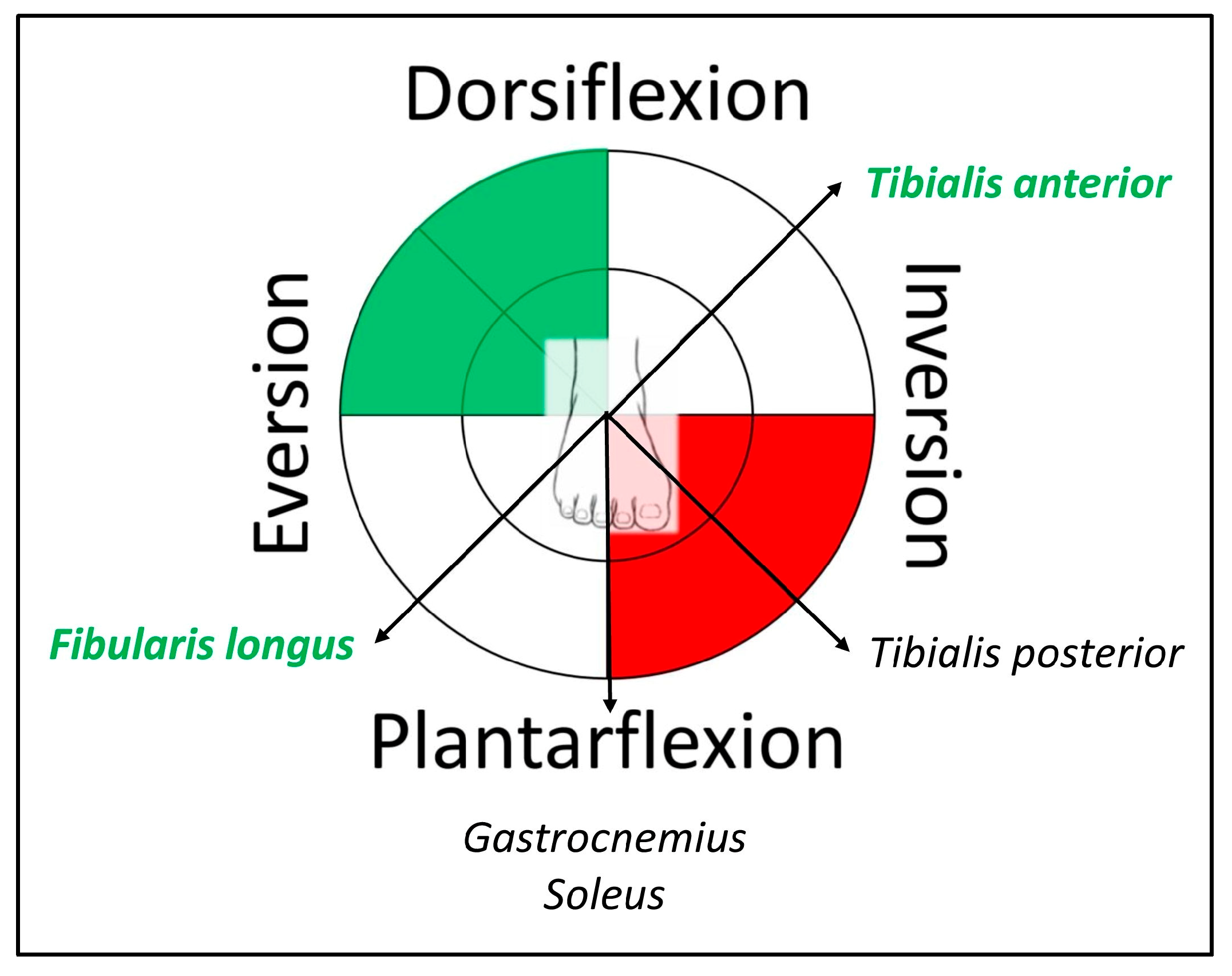

| Muscles | Test Positions (Joint Angles Measured Using Handheld Goniometer) | Instructions to Participants |
|---|---|---|
| Gluteus maximus | 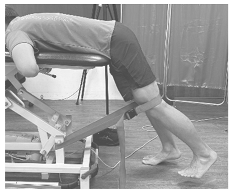 Prone with anterior superior iliac spine anchored to edge of plinth. Arms hug the sides of the plinth to maintain position. Hip is positioned in 45° hip flexion for tested leg. Gait belt is used to anchor distal thigh (above popliteal fossa). |
|
| Gluteus medius | 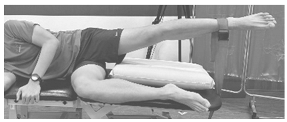 Side lying as shown in picture. Hand grips the edge of plinth to maintain position. Hip is positioned in 10° hip abduction for tested leg. Gait belt is used to anchor distal lower leg (above lateral ankle malleolus). |
|
| Vastus lateralis | 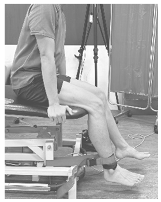 Seated over the edge of bed. Hands grip the sides of plinth to maintain position. Hip is positioned in 90° hip flexion. Knee is positioned in 60° knee flexion. Gait belt is used to anchor distal lower leg (above ankle malleoli). |
|
| Tibialis anterior | 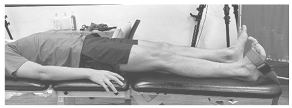 Lie flat in supine. Hip, knee and ankle joints are kept in neutral anatomical position. Gait belt is used to anchor distal dorsum of foot. |
|
| Fibularis longus | 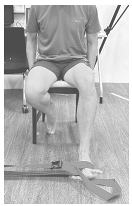 Seated on stable chair. Hands grip the sides of chair to maintain position. Hip is positioned in 90° hip flexion. Knee is positioned in 90° hip flexion. Heel is anchored to the ground with foot in slight plantarflexion. Gait belt is used to anchor distal lateral foot. |
|
| Gastrocnemius (medial head) | 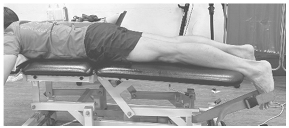 Prone flat on plinth. Arms hug the sides of the plinth to maintain position. Hip, knee, and ankle joints are kept in neutral anatomical position. Gait belt is used to anchor distal sole of foot. |
|
| Longissimus dorsi | 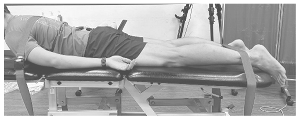 Prone flat on plinth as shown. Gait belt is used to anchor mid thoracic (T6–7), lower thoracic (T10–11), pelvic-hip, and above ankle malleoli. | Lift your head and back up and away from the plinth as hard as you can. |
| Demographics | Healthy (n = 16) | Recovered (n = 15) | CAI (n = 14) |
|---|---|---|---|
| Age, years, mean (SD) | 25.63 (3.93) | 25.60 (3.46) | 24.86 (2.38) |
| Gender, male, n (%) | 11 (68.75) | 13 (81.25) | 6 (42.86) |
| Height, m, mean (SD) | 1.67 (0.08) | 1.69 (0.09) | 1.64 (0.05) |
| Weight, kg, mean (SD) | 62.41 (10.77) | 68.21 (10.68) | 62.64 (12.51) |
| Body mass index, kg/m2, mean (SD) | 22.09 (3.08) | 23.88 (2.69) | 23.09 (3.35) |
| FAAM (ADL), %, mean (SD) | - | - | 81.36 (3.15) |
| Side of ankle sprain, n (%): | |||
| Left | - | 1 (6.67) | 2 (14.29) |
| Right | - | 12 (80) | 4 (28.57) |
| Bilateral | - | 2 (13.33) | 8 (57.14) |
| Leg dominance, right, n (%) | 14 (87.5) | 15 (100) | 14 (100) |
Disclaimer/Publisher’s Note: The statements, opinions and data contained in all publications are solely those of the individual author(s) and contributor(s) and not of MDPI and/or the editor(s). MDPI and/or the editor(s) disclaim responsibility for any injury to people or property resulting from any ideas, methods, instructions or products referred to in the content. |
© 2025 by the authors. Licensee MDPI, Basel, Switzerland. This article is an open access article distributed under the terms and conditions of the Creative Commons Attribution (CC BY) license (https://creativecommons.org/licenses/by/4.0/).
Share and Cite
Chua, Y.K.; Ang, J.R.C.; Wong, J.K.H.; Kwok, B.C. Electromyographic Validation of the DMA Clinical Pilates Method for Classifying Muscle Impairments in Chronic Ankle Instability. BioMed 2025, 5, 23. https://doi.org/10.3390/biomed5040023
Chua YK, Ang JRC, Wong JKH, Kwok BC. Electromyographic Validation of the DMA Clinical Pilates Method for Classifying Muscle Impairments in Chronic Ankle Instability. BioMed. 2025; 5(4):23. https://doi.org/10.3390/biomed5040023
Chicago/Turabian StyleChua, Yuen Keong, Jonas Rui Cheng Ang, John Kok Hong Wong, and Boon Chong Kwok. 2025. "Electromyographic Validation of the DMA Clinical Pilates Method for Classifying Muscle Impairments in Chronic Ankle Instability" BioMed 5, no. 4: 23. https://doi.org/10.3390/biomed5040023
APA StyleChua, Y. K., Ang, J. R. C., Wong, J. K. H., & Kwok, B. C. (2025). Electromyographic Validation of the DMA Clinical Pilates Method for Classifying Muscle Impairments in Chronic Ankle Instability. BioMed, 5(4), 23. https://doi.org/10.3390/biomed5040023






